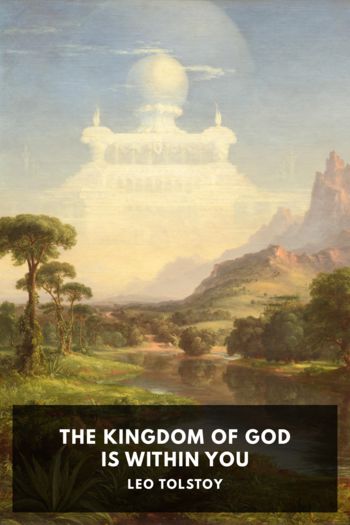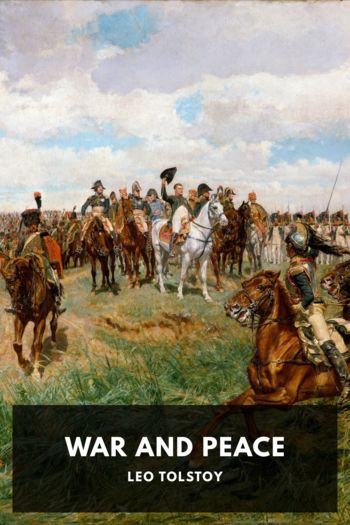author - "Leo Tolstoy"

Description
The Kingdom of God Is Within You is the most influential work of Christian anarchism. It might be considered the founding work of that tradition if it didn’t itself claim to merely be pointing out Christian anarchism as the plain meaning of the gospels.
Tolstoy argues that institutional Christianity with its doctrines, church hierarchies, and ritual practices, is anti-Christian. Christ, he says, explicitly told his followers to reject doctrines, church institutions and hierarchies, and ritual practices, and instead to love truth, to honor God, and to treat all people as your family and as you would want to be treated.
Tolstoy says that a Christian cannot participate in the political system, which is based on the use of violence to enforce the separation of people and the privileging of some people over others, and at the same time follow Jesus in his command to love your neighbor.

Description
Leo Tolstoy wrote this short meditation on sadness and the meaning of life when he was middle aged. He had already completed his masterworks, Anna Karenina and War and Peace, reared fourteen children, and gained fame and acclaim in Russia as a man of letters. But despite having attained that success, he still found himself unhappy and always returning to the disturbing idea that all achievement is meaningless.
A Confession is his attempt to put these thoughts in words as he teetered on the brink of suicide. It forms the first in a four-volume series that included A Criticism of Dogmatic Theology, The Gospel in Brief, and What I Believe (also known as My Religion or My Faith).

Description
In this short novel, Tolstoy fictionalizes the final days of Hadji Murád, a legendary Avar separatist who fought against, and later with, Russia, as the Russian Empire was struggling to annex Chechnya and the surrounding land in the late 1840s.
The novel opens with the narrator finding a thistle crushed in a blooming field, which reminds him of Hadji Murád and his tragic tale. As the narrator recounts the story, the reader is quickly thrust into the rich, colorful history of the Caucuses, and its people’s fight against Russian imperialism.
Hadji Murád is portrayed as a legendary and imposing, yet friendly and approachable figure. Despite his reputation, it seems that his best days are behind him; as the novel opens, Murád is fleeing Shamil, a powerful imam who has captured Murád’s family. Murád finds himself thrust between the invading Russians on one side, and Shamil’s vengeance on the other.
As Murád and his tiny but loyal group of warriors try to forge alliances in their attempt to rescue Murád’s family, they quickly find themselves politically outclassed. The Russians are Murád’s enemies, yet only they can help him in his struggle against Shamil; and after years of losses incurred by Murád’s guerrilla tactics, the Russians would like his help but cannot trust him. Shamil, on the other hand, is a deep link to the region’s complex web of tribal blood feuds, vengeances, reprisals, and quarrels over honor. He’s one of the few powers left standing between the Russians and their control of the Caucuses, but Murád, having crossed him, can’t rescue his family from Shamil’s clutches without the help of the Russians.
Murád’s impossible position, the contradiction between his legendary past and his limping, dignified, and ultimately powerless present, and the struggle against a mighty empire by a people torn by internecine conflict, form the major thematic threads of the novel.
The novel was one of the last that Tolstoy finished before his death, and was only published posthumously in 1912. Tolstoy himself served in the Crimean War, and the war scenes portrayed in the novel echo his personal experiences. As the story progresses, Tolstoy characterizes various real-life historical personalities besides Hadji Murád and Shamil, including Emperor Nicholas I, Mikhail Loris-Melikov, and Count Vorontsov-Dashkov, making this a fascinating piece of historical fiction. Despite this being such a late entry in Tolstoy’s corpus, it has been highly praised by critics both contemporary and modern, with the famous critic Harold Bloom going so far as to say that Hadji Murád is “my personal touchstone for the sublime of prose fiction, to me the best story in the world, or at least the best I have ever read.”

Description
Against the backdrop of the Napoleonic Wars, five aristocratic families in Russia are transformed by the vagaries of life, by war, and by the intersection of their lives with each other. Hundreds of characters populate War and Peace, many of them historical persons, including Napoleon and Tsar Alexander I, and all of them come to life under Tolstoy’s deft hand.
War and Peace is generally considered to be Tolstoy’s masterpiece, a pinnacle of Russian literature, and one of history’s great novels. Tolstoy himself refused to call it that, saying it was “not a novel, even less is it a poem, and still less a historical chronicle.” It contains elements of history, narrative, and philosophy, the latter increasing in quantity as the book moves towards its climax. Whatever it is called, it is a triumph whose breadth and depth is perhaps unmatched in literature.
This production restores the Russian given names that were anglicized by the Maudes in their translation, the use of Russian patronymics and diminutives that they eliminated, and Tolstoy’s original four-book structure.

Description
The Kingdom of God Is Within You is the most influential work of Christian anarchism. It might be considered the founding work of that tradition if it didn’t itself claim to merely be pointing out Christian anarchism as the plain meaning of the gospels.
Tolstoy argues that institutional Christianity with its doctrines, church hierarchies, and ritual practices, is anti-Christian. Christ, he says, explicitly told his followers to reject doctrines, church institutions and hierarchies, and ritual practices, and instead to love truth, to honor God, and to treat all people as your family and as you would want to be treated.
Tolstoy says that a Christian cannot participate in the political system, which is based on the use of violence to enforce the separation of people and the privileging of some people over others, and at the same time follow Jesus in his command to love your neighbor.

Description
Leo Tolstoy wrote this short meditation on sadness and the meaning of life when he was middle aged. He had already completed his masterworks, Anna Karenina and War and Peace, reared fourteen children, and gained fame and acclaim in Russia as a man of letters. But despite having attained that success, he still found himself unhappy and always returning to the disturbing idea that all achievement is meaningless.
A Confession is his attempt to put these thoughts in words as he teetered on the brink of suicide. It forms the first in a four-volume series that included A Criticism of Dogmatic Theology, The Gospel in Brief, and What I Believe (also known as My Religion or My Faith).

Description
In this short novel, Tolstoy fictionalizes the final days of Hadji Murád, a legendary Avar separatist who fought against, and later with, Russia, as the Russian Empire was struggling to annex Chechnya and the surrounding land in the late 1840s.
The novel opens with the narrator finding a thistle crushed in a blooming field, which reminds him of Hadji Murád and his tragic tale. As the narrator recounts the story, the reader is quickly thrust into the rich, colorful history of the Caucuses, and its people’s fight against Russian imperialism.
Hadji Murád is portrayed as a legendary and imposing, yet friendly and approachable figure. Despite his reputation, it seems that his best days are behind him; as the novel opens, Murád is fleeing Shamil, a powerful imam who has captured Murád’s family. Murád finds himself thrust between the invading Russians on one side, and Shamil’s vengeance on the other.
As Murád and his tiny but loyal group of warriors try to forge alliances in their attempt to rescue Murád’s family, they quickly find themselves politically outclassed. The Russians are Murád’s enemies, yet only they can help him in his struggle against Shamil; and after years of losses incurred by Murád’s guerrilla tactics, the Russians would like his help but cannot trust him. Shamil, on the other hand, is a deep link to the region’s complex web of tribal blood feuds, vengeances, reprisals, and quarrels over honor. He’s one of the few powers left standing between the Russians and their control of the Caucuses, but Murád, having crossed him, can’t rescue his family from Shamil’s clutches without the help of the Russians.
Murád’s impossible position, the contradiction between his legendary past and his limping, dignified, and ultimately powerless present, and the struggle against a mighty empire by a people torn by internecine conflict, form the major thematic threads of the novel.
The novel was one of the last that Tolstoy finished before his death, and was only published posthumously in 1912. Tolstoy himself served in the Crimean War, and the war scenes portrayed in the novel echo his personal experiences. As the story progresses, Tolstoy characterizes various real-life historical personalities besides Hadji Murád and Shamil, including Emperor Nicholas I, Mikhail Loris-Melikov, and Count Vorontsov-Dashkov, making this a fascinating piece of historical fiction. Despite this being such a late entry in Tolstoy’s corpus, it has been highly praised by critics both contemporary and modern, with the famous critic Harold Bloom going so far as to say that Hadji Murád is “my personal touchstone for the sublime of prose fiction, to me the best story in the world, or at least the best I have ever read.”

Description
Against the backdrop of the Napoleonic Wars, five aristocratic families in Russia are transformed by the vagaries of life, by war, and by the intersection of their lives with each other. Hundreds of characters populate War and Peace, many of them historical persons, including Napoleon and Tsar Alexander I, and all of them come to life under Tolstoy’s deft hand.
War and Peace is generally considered to be Tolstoy’s masterpiece, a pinnacle of Russian literature, and one of history’s great novels. Tolstoy himself refused to call it that, saying it was “not a novel, even less is it a poem, and still less a historical chronicle.” It contains elements of history, narrative, and philosophy, the latter increasing in quantity as the book moves towards its climax. Whatever it is called, it is a triumph whose breadth and depth is perhaps unmatched in literature.
This production restores the Russian given names that were anglicized by the Maudes in their translation, the use of Russian patronymics and diminutives that they eliminated, and Tolstoy’s original four-book structure.
